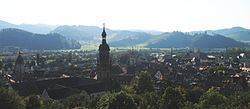Government Elective principality Unsuccessfully attempted to join College of Prelates 1575 and 1580 Founded 1007 | Languages Alemannic Joined College of Prelates 1645 / 1751 1803 Date dissolved 1803 | |
 | ||
Benedict monastery gengenbach abbey
Gengenbach Abbey (German: Kloster Gengenbach) was a Benedictine monastery in Gengenbach in the district of Ortenau, Baden-Württemberg, Germany. It was an Imperial Abbey from the late Carolingian period to 1803.
Contents
History
It was founded by Saint Pirmin (d. 735) sometime after his expulsion from Reichenau in 727 and settled by monks from Gorze Abbey. It enjoyed good relations with the Carolingian dynasty and soon became an Imperial abbey, with territorial independence. In 1007, however, Emperor Henry II presented it to his newly founded Prince-Bishopric of Bamberg. Whilst situated within the Ortenauer Reichslandvogtei, under the protection of Rudolph of Habsburg (1273–91), the territory's protectors were an array of local lords: the Zähringen were followed in 1218 by the Staufen dukes of Swabia and in 1245 by the bishops of Strasbourg until the 1550s. These Vögte and confirmations of their rights — both Papal (1139, 1235, 1252, 1287) and Imperial (1309, 1331, 1516) — ensured the Abbey's continual independence.
Gengenbach was deeply embroiled in the Investiture Controversy and two of its abbots were driven out for supporting the Imperial rather than the Papal cause. Shortly after this, the abbey was involved by Abbot Theoger (1080–1139) of St. George's Abbey in the Black Forest and Bishop Otto of Bamberg in the Hirsauer Reform, during which the abbey church was demolished and rebuilt to the Hirsau model. Subsequently, it has been remodelled in the Gothic, Baroque and neo-Romanesque styles.
During the 13th and 14th centuries, the abbey was instrumental in developing the town of Gengenbach to economic maturity. The abbey avoided further monastic reforms, and although in danger of suppression during the Reformation, survived that too.
In 1575 and 1580, the abbey applied for membership of the Imperial College of Prelates but was refused, due to concern about its Imperial immediacy and Vogtei; membership was eventually approved in 1645 but this approval was not implemented until 1751. The abbey was mediatized in the wake of the German Mediatisation of 1803, and shortly afterwards its territories were absorbed into the state of Baden. However, the abbey was left to function under the last abbot until 1807 when the Grand Duke ordered it secularized.
